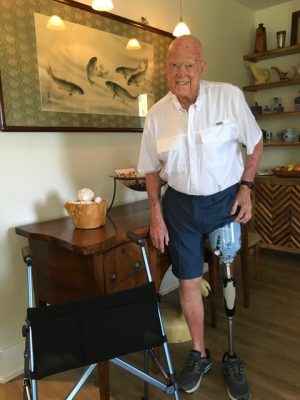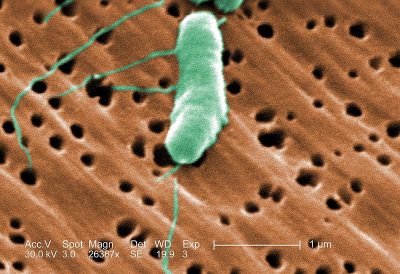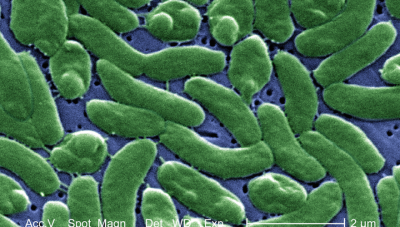ORIENTAL – Fifteen minutes.
That’s roughly the amount of time Richard Flaherty spent in 2 to 3 inches of flood waters helping a neighbor the day after Hurricane Florence made landfall last year.
Supporter Spotlight

Twenty-four hours later, Flaherty’s left leg had been amputated above the knee. His odds of survival were 50-50 before his leg was removed.
“That’s when my prayers started immediately that he was going to be on the good side of 50,” said his wife, Penny Flaherty.
Within three days following the amputation in CarolinaEast Medical Center in New Bern, Richard Flaherty, then 77, was back in the operating room. This time, doctors removed a chunk of flesh and muscle from his right calf.
Bacteria known as Vibrio vulnificus, which he came into contact with in the floodwaters Sept. 15, 2018, had migrated.
Penny Flaherty remembers well what the doctor who amputated her husband’s leg said when he saw Richard three weeks after that initial operation: “You’re my miracle man.”
Supporter Spotlight
“I think it is,” a miracle, Penny Flaherty said.
According to the Centers for Disease Control and Prevention, about one in five people with the infection die, sometimes within a couple of days after the bacteria enter the body.
In the midst of hurricane season, which runs June 1 – Nov. 30, Penny Flaherty wants to warn others by sharing her husband’s story.
“This should promptly be put out there before hurricane season,” she said.
While V. vulnificus is a concern following hurricanes, the bacteria are not directly related to pollution, but occur naturally in warm waters such as bays, estuaries and rivers close to the ocean during the summer months.
About 80 percent of vibrio infections occur between May and October, according to the CDC.

The CDC estimates vibriosis causes 80,000 illnesses each year in the U.S. About 52,000 contract it as the result of eating contaminated shellfish. Vibrio parahaemolyticus is the most commonly reported species and is estimated to cause 45,000 illnesses a year in the U.S.
Between 1999 and 2003, 27 North Carolinians were infected by V. vulnificus, according to the North Carolina Department of Environmental Quality. Seventy percent of those cases were wound infections, many as a result of someone cutting or scratching themselves while handling crabs or having an open wound, cut or sore and coming into contact where there were high levels of the bacteria in brackish waters.
A Wilmington man died Sept. 25 last year after cutting his leg during hurricane cleanup and getting floodwater into the wound. That same day, New Hanover County officials issued a press release warning about the risk of vibrio.
Richard Flaherty did not have so much as a scratch on his ankle when he walked into the floodwaters last September, his wife said. But, he has thin skin, she added, and a history of skin cancers resulting from radiation exposure during his time in the Air Force. Those factors may have made him more susceptible to the bacteria.
Those who cannot avoid coming into contact with flood waters are urged to take the following precautions:
- Wear clothes and shoes that protect you from cuts and scrapes when in brackish or salt water.
- Wear protective gloves.
- Wash wounds and cuts thoroughly with soap and water if they have been exposed to brackish, salt, flood waters, or even raw seafood or seafood juices.
- Cover your wound with a waterproof bandage if there’s a possibility it could come into contact with brackish or salt waters, floodwaters or raw seafood or seafood juices.
- If you develop a skin infection, tell your medical provider if your skin has come into contact with brackish or salt waters, floodwaters or raw seafood or seafood juices.
- Always wash your hands with soap and water after handing raw shellfish.
- Avoid contaminating cooked shellfish with raw shellfish and its juices.
- Have the following vaccines: Hepatitis A, Td (Tetanus & Diphtheria), and Tdap (Tetanus, diphtheria and pertussis).
The symptoms of infected wounds include pain, swelling and redness that may rapidly spread or blister.
“It looked like it could have been a spider bite, maybe a snake bite.”
Penny Flaherty
“It looked like it could have been a spider bite, maybe a snake bite,” Penny Flaherty said of her husband’s wound, which started as a little red mark on his right ankle.
Emergency medical technicians who responded to her 911 call on the evening of Sept. 15 gave her husband Benadryl and Tylenol and instructed him to take those medications every few hours, she said.
When Penny Flaherty started to administer the medications to her husband at 5 a.m. the following day, the red spot had spread to blood-filled, oozing blisters, she said.
“I was so stunned that I called 911 immediately,” she said. “He was in a lot of pain and his temperature was about 103.”
Emergency responders assisted her husband down the stairs from the front door of their home and into an ambulance, she said. Richard Flaherty was diagnosed with V. vulnificus at the hospital.
Pamlico County officials do not have a record of anyone contracting the bacteria last September, according to Chris Murray, Pamlico County’s Emergency Management director and fire marshal.

“We are very aware of waterborne illnesses,” he said. “We’re very versed in it and aware of it.”
Richard Flaherty spent almost 22 days in the intensive care unit. He was discharged from the hospital after 41 days.
There’s been nearly six months of wound care and physical therapy. The Flahertys’ bedroom in their home across the street from the Neuse River in Oriental has been converted to something more of hospital room.
They’ve dealt with red tape while seeking help to cover some of the costs for everything from his wheelchair to physical therapy teaching him how to walk on a prosthetic leg.
They continue to travel to Durham every two weeks for immune infusion treatments, something he has been receiving for three months now, Penny Flaherty said.
“I have been the ever-present nurse on duty 24/7,” she said. “My care for him is what I do. That’s my full-time job. We’re making changes almost every week about something. But there’s things that will never change and things he will never do again. We both cry a lot. We laugh a lot.”








